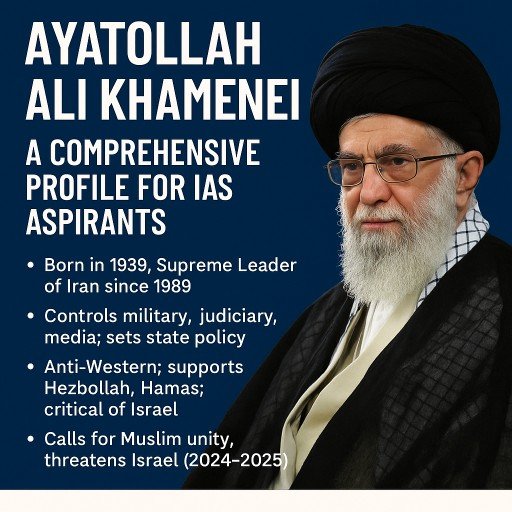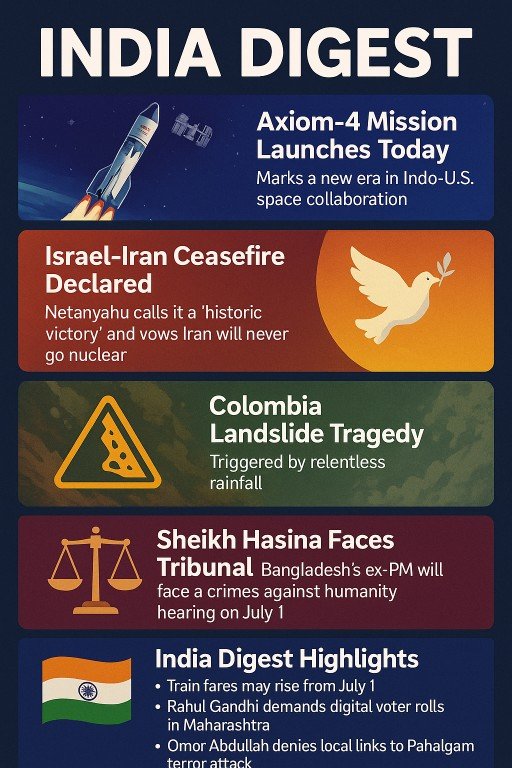Introduction
Ayatollah Ali Khamenei, Iran’s Supreme Leader since 1989, is a pivotal figure in global politics, wielding unparalleled authority over Iran’s governance, military, and foreign policy. For IAS aspirants, understanding Khamenei’s role, influence, and recent activities is essential, as Iran’s actions under his leadership significantly impact Middle Eastern geopolitics and India’s strategic interests. This article provides a detailed overview of Khamenei’s background, powers, policies, and relevance for the UPSC syllabus, incorporating recent statements from X posts.
Background and Early Life
Born on April 19, 1939, in Mashhad, Iran, Ali Khamenei hails from a family of religious scholars. His father, Javad Khamenei, was a cleric, and Ali began his religious education at age four, studying the Quran and later Islamic jurisprudence in Mashhad and Qom. In Qom, he studied under prominent scholars, including Ayatollah Ruhollah Khomeini, who would later lead the Iranian Revolution.
Khamenei’s early life was marked by political activism against the Pahlavi monarchy. He was arrested six times and exiled for three years due to his opposition activities. His close association with Khomeini positioned him as a key figure in the 1979 Iranian Revolution, which overthrew the Shah and established the Islamic Republic.
- Key Fact: Khamenei’s education in Qom under Khomeini shaped his revolutionary ideology.
- Source: Wikipedia: Ali Khamenei
Political Career and Rise to Power
Following the 1979 Revolution, Khamenei held several significant roles:
- 1979: Appointed to the Revolutionary Council.
- 1981–1989: Served as President of Iran, navigating the Iran-Iraq War and consolidating revolutionary governance.
- 1989: Succeeded Khomeini as Supreme Leader, a lifetime appointment under Iran’s constitution.
His presidency and subsequent leadership reflect his commitment to the revolutionary ideals of anti-imperialism and Islamic governance. As Supreme Leader, he transitioned from a political figure to the ultimate arbiter of state policy.
- Key Fact: Khamenei’s appointment as Supreme Leader was unexpected, as he was not initially a high-ranking cleric.
- Source: Britannica: Ali Khamenei
Role and Powers as Supreme Leader
The Supreme Leader is the highest authority in Iran, with powers outlined in the 1979 Constitution:
- Governance: Supervises the executive, legislative, and judicial branches (Article 57).
- Military: Commands the armed forces, including the Islamic Revolutionary Guard Corps (IRGC).
- Appointments: Appoints heads of the judiciary, military, and state media, as well as members of the Guardian Council.
- Policy: Sets the general policies of the Islamic Republic (Article 110), with final say on foreign affairs, economy, and national security.
Khamenei’s decisions are binding, and his office ensures the Islamic character of the state. He has issued decrees on issues ranging from elections to environmental policy, demonstrating his extensive influence.
- Key Fact: Khamenei controls key institutions like the Guardian Council, which vets election candidates.
- Source: Wikipedia: Supreme Leader of Iran
Foreign Policy and Regional Influence
Khamenei’s foreign policy is rooted in anti-Western sentiment and support for anti-imperialist movements. Key aspects include:
- Anti-Western Stance: He has consistently opposed U.S. and Israeli policies, positioning Iran as a counterweight to Western hegemony.
- Regional Alliances: Supports groups like Hezbollah in Lebanon and Hamas in Gaza, as well as the Syrian government.
- Nuclear Program: Oversees Iran’s nuclear ambitions, a contentious issue in global diplomacy.
Recent X posts highlight his assertive rhetoric:
- On October 4, 2024, Khamenei called for Muslim unity and defense against external threats, stating, “Muslims should no longer be negligent. We must tighten the belt of defense and independence” (X Post: PalMediaOrg).
- On June 13, 2025, he declared that Iran’s armed forces would act to bring Israel to “collapse and impotence” (X Post: FGaitho237).
These statements underscore Iran’s confrontational stance, particularly amid escalating tensions with Israel.
- Key Fact: Khamenei’s support for proxy groups enhances Iran’s regional influence but fuels tensions.
- Source: The Guardian: Ali Khamenei
Recent Developments and Statements
Khamenei remains active in shaping Iran’s policies, with recent activities reflecting his focus on unity and defense:
- Islamic Unity: On September 16, 2024, he met with Sunni scholars, emphasizing that “Islamic unity is not merely a tactic but a principle” to counter Shia-Sunni discord (X Post: iranscreenshot).
- Public Appearances: On October 4, 2024, he was seen holding a Russian-made Dragunov rifle during a sermon, symbolizing Iran’s defiance against Israel (X Post: IndiaToday).
- Succession Planning: Reports suggest Khamenei is preparing for potential assassination risks by selecting replacements for military commanders and possibly himself, though details are limited (New York Times: Ayatollah Khamenei).
Unverified health rumors have circulated, including claims of terminal cancer or a coma, but no official sources confirm these, and his recent activities suggest he remains in control.
- Key Fact: Khamenei’s public appearances counter health rumors, but succession remains a critical issue.
- Source: The Indian Express: Ayatollah Khamenei
Significance for India and UPSC Aspirants
Iran’s strategic location and resources make it a key player for India:
- Economic Ties: Iran is a major oil supplier, and the Chabahar Port project enhances India’s connectivity to Central Asia, bypassing Pakistan.
- Geopolitical Alignment: India balances relations with Iran, the U.S., and Israel, navigating complex regional dynamics.
- UPSC Relevance: Khamenei’s policies are pertinent to syllabus topics like:
- International Relations: Iran’s role in Middle Eastern conflicts and nuclear negotiations.
- Current Affairs: Recent tensions with Israel and Iran’s regional influence.
- Political Science: Theocratic governance and leadership dynamics in Iran.
Aspirants should note Iran’s impact on global energy markets and India’s strategic projects, as these are frequent UPSC themes.
- Key Fact: Chabahar Port is a cornerstone of India-Iran cooperation.
- Source: The Hindu: Ayatollah Khamenei
Controversies and Perspectives
Khamenei’s leadership elicits polarized views:
- Supporters: View him as a resolute defender of Islamic values and Iran’s sovereignty, resisting Western dominance.
- Critics: Accuse him of overseeing repression, including crackdowns on dissent and human rights concerns, though these claims are debated.
For UPSC aspirants, it’s important to approach such controversies objectively, analyzing both perspectives to form balanced answers.
- Key Fact: Khamenei’s cult of personality is strong among supporters, but critics highlight governance challenges.
- Source: Wikipedia: Ali Khamenei
Conclusion
Ayatollah Ali Khamenei’s leadership has defined Iran’s trajectory for over three decades, shaping its revolutionary identity and regional ambitions. His anti-Western policies, support for proxy groups, and recent calls for Muslim unity underscore Iran’s assertive stance. For IAS aspirants, understanding Khamenei’s role is vital for mastering international relations and current affairs. As Iran navigates tensions with Israel and plans for succession, Khamenei’s legacy will continue to influence global geopolitics, making him a critical figure for UPSC preparation.
Key Points for Quick Revision
| Aspect | Details |
|---|---|
| Position | Supreme Leader of Iran since 1989. |
| Background | Born 1939, Mashhad; studied under Khomeini; active in 1979 Revolution. |
| Powers | Controls military, judiciary, media; sets state policy. |
| Foreign Policy | Anti-Western; supports Hezbollah, Hamas; critical of Israel. |
| Recent Statements | Calls for Muslim unity (Oct 2024); threatens Israel (Jun 2025). |
| Health Rumors | Unconfirmed reports of illness; remains active as of Jun 2025. |
| India’s Interest | Chabahar Port, energy security, regional stability. |
| UPSC Relevance | International relations, current affairs, political science. |



